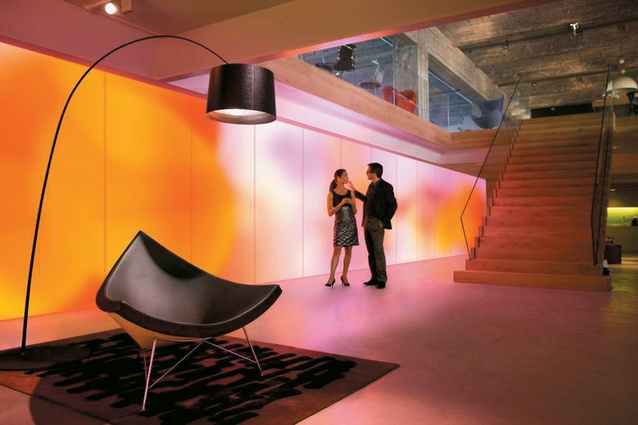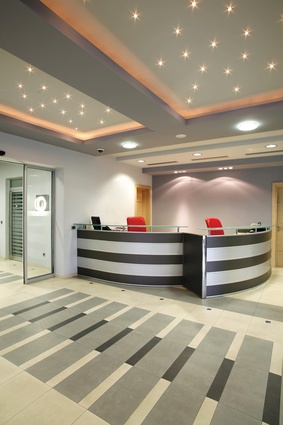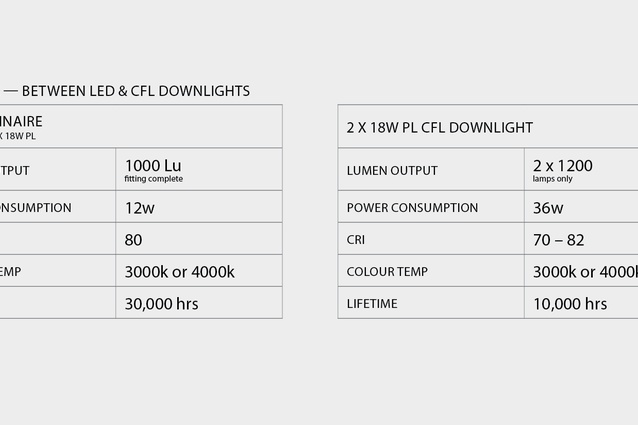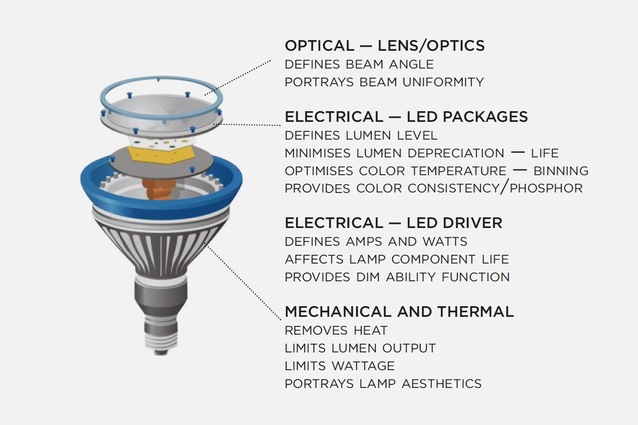LED lighting for commercial interiors
LED technology provides a number of benefits: it can last up to twenty-five times longer than standard incandescent lighting and uses up to 80% less energy. 1 LEDs also provide illumination without emitting infrared and ultraviolet radiation. These characteristics have seen lighting experts predict LED lighting will make up at least 45% of global lighting by as early as 2015, and 75% by the end of this decade. 2
Lighting accounts for up to 40% of the energy used in commercial offices 3 thus more efficient lighting products can bring significant energy savings. When combined with daylight-harvesting lighting controls (which recognise light levels outside and adjust interior lighting accordingly) and movement-detection sensors (which identify when workspaces are occupied and adjust lighting accordingly) energy efficiencies of
up to 70% can be made. 4
In addition to these energy and cost savings, LED technology enables new tools for design professionals to create innovative and creative spaces.
Philips partnered with ceiling tile manufacturer Armstrong to develop ceiling panels with built-in energy-efficient lighting. These panels are significantly thinner than regular lighting installed in ceiling panels, enabling greater ceiling heights — particularly useful when older building are being retrofitted to achieve Green Star ratings.
A new international partnership with Kvadrat Soft Cells has developed luminous textiles by integrating Philips’s LEDs into Kvadrat’s acoustic panels.
A study commissioned by Philips and undertaken by City University London’s Centre for Performance at Work emphasised the importance of lighting to worker productivity, 5 something also illustrated in the 2006 paper by the New Zealand Parliamentary Commissioner for the Environment, which found that improved lighting design increased worker productivity by up to 23%. 6
The potential for lighting conditions to improve worker productivity was behind Philips’s recent research into adjusting lighting colour and intensity to suit mood and activity, rather than using a constant harsh, cold light. In Audi’s office in Germany, Philips has installed a lighting control system that turns lights on and off according to the time of day and amount of natural light. New lighting technology can be programmed to simulate natural daylight, to stay in tune with people’s natural biorhythms. In a trial at Westraven Tower, a twenty-three-storey office block in the Netherlands where this was done, staff reported feeling more energised and having a greater sense
of wellbeing. 7
There are a number of these types of LED lamps, luminaires, and control systems now available in the New Zealand market. Below are a few myth-busting facts to assist you in choosing the best LED options for your designs:
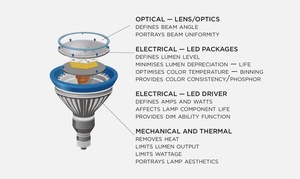
MYTH: LEDs are not bright enough
LED traffic lights are already common, demonstrating that LEDs are bright enough to be seen in daylight. Rooms, tunnels and entire building facades have been lit entirely with LEDs. LEDs have enough light output for use even in very large outdoor daylight-visible installations.
MYTH: Three-watt LEDs are brighter than one-watt LEDs
People are used to looking at wattage to determine the output of a light source. However, the wattage of an LED is not directly comparable to either the wattage of a traditional light source or even from one LED to another. Therefore, light output and light extraction efficacy, rather than raw wattage, are the key factors when looking at an LED source. Efficacy is the amount of light in lumens to the power used in watts or lumens per watt. So when selecting LEDs or LED fixtures, it is more about light output, than power, so you need to look for the lumens per watt of the system.
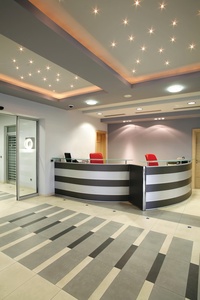
MYTH: LED light quality is poor
There are several measures used to describe light. Color temperature characterises the colour appearance of a source and describes the apparent warmth or coolness of that light source. The Colour Rendering Index (CRI) is a metric used to measure the quality of light.
The CRI for many white-light LED systems is typically 75–85 (out of 100), and continues to improve rapidly, making it suitable for nearly all lighting applications.
MYTH: LEDs last forever
LEDs have a long source life but, like all light sources, they slowly fade over time. Ambient temperatures, electrical drive currents, and the effectiveness of cooling systems in the lamps and luminaires are all factors that contribute to lumen depreciation. A typical lifespan for LED lamps is 25,000 burning hours, and for fixtures 30,000 to 50,000 burning hours.
MYTH: LEDs generate no heat
When used in lighting applications, LEDs do not radiate infrared heat, only visible light. However, waste heat is produced during the conversion of electricity into
light and, if not properly removed from the lighting system, may potentially damage the LEDs. Heat removal can be accomplished through carefully designed and engineered heat sinks from manufacturers that take these thermal issues into account. The larger the heat sink, the more efficiently and effectively heat is drawn away from the LED and dissipated into the surrounding air.
MYTH: LED systems are expensive
The return on investment (ROI) for the use of LED lighting systems in an installation is surprisingly rapid when taking maintenance and energy cost savings into consideration. In many cases, economic payback can be seen in two to three years. Additionally, the upfront cost of LED systems is continuing to drop rapidly.
Foot notes:
- “Light Emitting Diodes,” RightLight, www.rightlight.govt.nz/residential/choosing-right-light/types-bulbs/light-emitting-diodes.
- Philips Lighting global market study 2013.
- UTC Power, presented in the Energy Efficient Building Seminar, May 2007, Beijing, China.
- Philips Lighting case studies: Rundbau (Germany), Abbey Bank (UK).
- “Lighting, Wellbeing and Performance at Work,” study commissioned by Philips and carried out by City University London’s Centre for Performance at Work.
- “A health impact assessment of Future currents: Electricity scenarios for New Zealand 2005–2050,” Parliamentary Commissioner for the Environment, 2006.
- Philips Lighting case study: Westraven, Utrecht, the Netherlands, www.lighting.philips.co.nz/projects/westraven.wpd?CID=nl.

